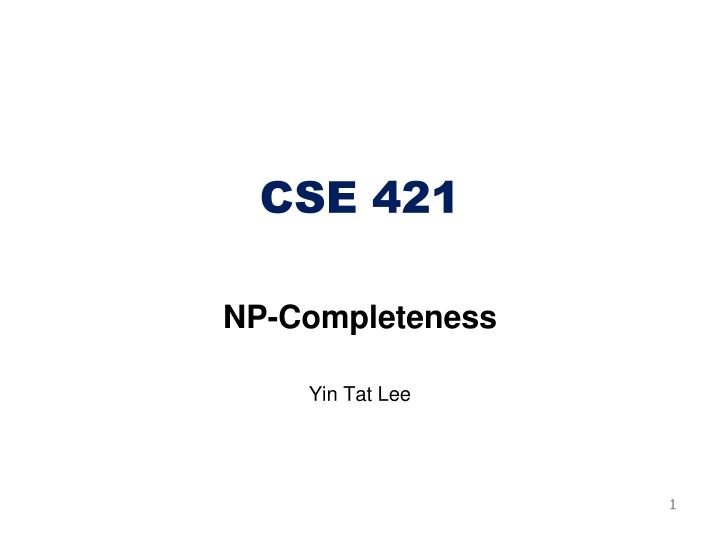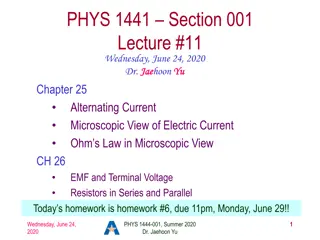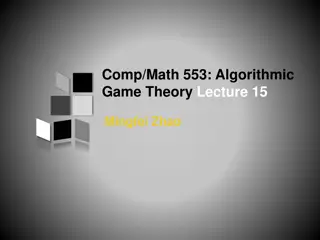
Computational Complexity: NP-Completeness and Reductions
Explore NP-Completeness, computational complexity, relative complexity of problems, and polynomial-time reductions. Learn about fine-grained complexity and the implications for problem-solving algorithms.
Uploaded on | 1 Views
Download Presentation

Please find below an Image/Link to download the presentation.
The content on the website is provided AS IS for your information and personal use only. It may not be sold, licensed, or shared on other websites without obtaining consent from the author. If you encounter any issues during the download, it is possible that the publisher has removed the file from their server.
You are allowed to download the files provided on this website for personal or commercial use, subject to the condition that they are used lawfully. All files are the property of their respective owners.
The content on the website is provided AS IS for your information and personal use only. It may not be sold, licensed, or shared on other websites without obtaining consent from the author.
E N D
Presentation Transcript
CSE 421 NP-Completeness Yin Tat Lee 1
Computational Complexity Goal: Classify problems according to the amount of computational resources used by the best algorithms that solve them Here we focus on time complexity Recall: worst-case running time of an algorithm max # steps algorithm takes on any input of size n 2
Relative Complexity of Problems Want a notion that allows us to compare the complexity of problems Want to be able to make statements of the form If we could solve problemB in polynomial time then we can solve problem Ain polynomial time Problem B is at least as hard as problem A 3
Polynomial Time Reduction B: if there is an algorithm for problem A using a Def A P black box (subroutine) that solve problem B s.t., Algorithm uses only a polynomial number of steps Makes only a polynomial number of calls to a subroutine for B So, B is Polynomial time solvable A is Polynomial time solvable Conversely, No efficient Algorithm for B No efficient Algorithm for A In words, B is as hard as A (it can be even harder) 4
1 Reductions ? Here, we often use a restricted form of polynomial-time reduction often called Karp reduction. 1?: if and only if there is an algorithm for Agiven a ? ? black box solving B that on input x Runs for polynomial time computing an input f(x) of B Makes one call to the black box for B for input f(x) Returns the answer that the black box gave We say that the function f(.) is the reduction 5
Answer Let A = bipartite matching. Let B = maxflow. We know how to solve bipartite matching by calling maxflow once. So, it may look like the answer is Both ? ?? and ? ? 1?. However, since both problems can be solved in polynomial time, one valid reduction would be simply doing nothing. Hence, all statements are true. So, ? is mainly to distinguish if a problem is in P or not. 7
Fine-Grained Complexity There are recent work on distinguishing different polytime. 8
Example 1: Indep Set ? Clique Indep Set: Given G=(V,E) and an integer k, is there ? ? s.t. ? ? and no two vertices in S are joined by an edge? Clique: Given G=(V,E) and an integer k, is there ? ?, |U| k s.t., every pair of vertices in S is joined by an edge? Claim: Indep Set ? Clique Pf: Given ? = (?,?) and instance of indep Set. Construct a new graph ? = (?,? ) where ?,? ? if and only if ?,? ?. 1 1 2 5 5 2 3 4 3 4 S is an indep set in G S is a clique in G 9
Example 2: Vertex Cover ? Indep Set Vertex Cover: Given G=(V,E) and an integer k, is there a vertex cover of size at most k? Claim: For any graph ? = ?,? , S is an independent set iff ? ? is a vertex cover Pf: => Let S be an independent set of G Then, ? has at most one endpoint of every edge of G So, ? ? has at least one endpoint of every edge of G So, ? ? is a vertex cover. <= Suppose ? ? is a vertex cover Then, there is no edge between vertices of S (otherwise, ? ? is not a vertex cover) So, ? is an independent set. 10
Example 3: Vertex Cover ? Set Cover Set Cover: Given a set U, collection of subsets ?1, ,?? of U and an integer k, is there a collection of k sets that contain all elements of U? Claim: Vertex Cover ? Set Cover Pf: Given (? = ?,? ,?) of vertex cover we construct a set cover input ?(?,?) ? = ? For each ? ? we create a set ?? of all edges connected to ? This clearly is a polynomial-time reduction So, we need to prove it gives the right answer 11
Example 3: Vertex Cover ? Set Cover Claim: Vertex Cover ? Set Cover Pf: Given (? = ?,? ,?) of vertex cover we construct a set cover input ?(?,?) ? = ? For each ? ? we create a set ?? of all edges connected to ? Vertex-Cover (G,k) is yes => Set-Cover f(G,k) is yes If a set ? ? covers all edges, just choose ?? for all ? ?, it covers all ?. Set-Cover f(G,k) is yes => Vertex-Cover (G,k) is yes If (??1, ,???) covers all ?, the set {?1, ,??} covers all edges of G. 12
Decision Problems A decision problem is a computational problem where the answer is just yes/no Here, we study computational complexity of decision Problems. Why? Simpler to deal with Decision version is not harder than Search version, so it gives a lower bound for Decision version usually, you can use decider multiple times to find an answer. 13
Polynomial Time Define P (polynomial-time) to be the set of all decision problems solvable by algorithms whose worst-case running time is bounded by some polynomial in the input size. Do we understand P? We can prove that a problem is in P by exhibiting a polynomial time algorithm It is in most cases very hard to prove a problem is not in P. 14
Beyond P? We have seen many problems that seem hard Independent Set 3-coloring Vertex Cover 3-SAT Given a formula ?1 ?2 ?9 ?2 ?3 ?7 , is there a satisfying assignment? The independent set S The 3-coloring The vertex cover S The T/F assignment Common Property: If the answer is yes, there is a short proof (a.k.a., certificate), that allows you to verify (in polynomial-time) that the answer is yes. The proof may be hard to find 15
Decision Problems A decision problem is a computational problem where the answer is just yes/no. We can define a problem by a set ? 0,1?. The answer for the input ? is YES iff ? ?. Certifier: Algorithm C(s, t) is a certifier for problem A if ? ? if and only if (There is a ? such that ? ?,? = ???)) NP: Set of all decision problems for which there exists a poly- time certifier. Co-NP: ? ?? ?? if and only if ? ??. 16
Example: 3SAT is in NP Given a 3-CNF formula, is there a satisfying assignment? (conjunctive normal form (CNF) is AND of ORs) Certificate: An assignment of truth values to the n boolean variables. Verifier: Check that each clause has at least one true literal. Ex: ?1 ?3 ?4 ?2 ?4 ?3 (?2 ?1 ?3) Certificate: ?1= ?,?2= ?,?3= ?,?4= ? Conclusion: 3-SAT is in NP 17
Question: Is Maxflow is in NP? Decision problem: Is the maximum flow value = k? Answer 1: Certificate: A flow ? and a cut ?,? Verifier: Check if ??? ? = ???(?,?) Answer 2: Certificate: None Verifier: Any polynomial time maxflow algo. 18
What do we know about NP? Nobody knows if all problems in NP can be done in polynomial time, i.e. does P=NP? one of the most important open questions in all of science. Huge practical implications specially if answer is yes Every problem in P is in NP one doesn t even need a certificate for problems in P so just ignore any hint you are given Every problem in NP is in exponential time Some problems in NP seem really hard nobody knows how to prove that they are really hard to solve, i.e. ? ?? 19
NP Completeness Complexity Theorists Approach: We don t know how to prove any problem in NP is hard. So, let s find hardest problems in NP. NP-hard: A problem B is NP-hard iff for any problem ? ??, we have ? ?? NP-Completeness: A problem B is NP-complete iff B is NP-hard and ? ??. Motivations: If ? ??, then every NP-Complete problems is not in P. So, we shouldn t try to design Polytime algorithms To show ? = ??, it is enough to design a polynomial time algorithm for just one NP-complete problem. 20
Cook-Levin Theorem Theorem (Cook 71, Levin 73): 3-SAT is NP-complete, i.e., for all problems ? ??,? ? 3-SAT. Pf (Draft. Take CSE 431 for more.): Since ? ??, there is a polytime certifier ? such that ? ? iff ? ?,? = 1 for some ? To solve the problem ?, it suffices to find ?. Since ? is polytime, we can convert ? to a poly size circuit (of AND OR NOT) Some input are the given ?. Some input are ?. Our goal is to find ? to make the output is TRUE. 21
Cook-Levin Theorem Theorem (Cook 71, Levin 73): 3-SAT is NP-complete, i.e., for all problems ? ??,? ? 3-SAT. Pf (Draft. Take CSE 431 for more.): To find an input such that output is true, we convert the circuit to 3CNF ?1 ?2 ?9 ?2 ?3 ?7 Example: An OR gate with input a,b and output c can be represented by ? ? ? (? ?) (? ?) A NOT gate with input a and output c can be represented by ? ? (? ?) Suppose the circuit gate ?1,?2, ,?? with final output ? Then, the 3CNF is ?1 ?2 ?? ? where ?? are the 3CNF version of ??. 22
Cook-Levin Theorem Theorem (Cook 71, Levin 73): 3-SAT is NP-complete, i.e., for all problems ? ??,? ? 3-SAT. So, 3-SAT is the hardest problem in NP. What does this say about other problems of interest? Like Independent set, Vertex Cover, Fact: If ? ?? and ? ?? then, ? ?? Pf idea: Just compose the reductions from A to B and B to C So, if we prove 3-SAT ? Independent set, then Independent Set, Clique, Vertex cover, Set cover are all NP-complete 3-SAT ? Independent Set ? Vertex Cover ? Set Cover 23
3-SAT ? Independent Set Map a 3-CNF to (G,k). Say m is number of clauses Create a vertex for each literal Joint two literals if They belong to the same clause (blue edges) The literals are negations, e.g., ??, ?? (red edges) Set k be the # of clauses. ?1 ?3 ?4 ?2 ?4 ?3 ?2 ?1 ?3 ?1 ?2 ?2 Polynomial-Time Reduction ?3 ?4 ?1 ?4 ?3 ?3 24
Correctness of 3-SAT ? Indep Set F satisfiable => An independent of size k Given a satisfying assignment, Choose one node from each clause where the literal is satisfied ?1 ?3 ?4 ?2 ?4 ?3 ?2 ?1 ?3 Satisfying assignment: ?1= ?,?2= ?,?3= ?,?4= ? ?1 ?2 ?2 ?3 ?4 ?1 ?4 ?3 ?3 S has exactly one node per clause => No blue edges between S S follows a truth-assignment => No red edges between S S has one node per clause => |S|=k 25
Correctness of 3-SAT ? Indep Set An independent set of size k => A satisfying assignment Given an independent set S of size k. S has exactly one vertex per clause (because of blue edges) S does not have ??, ?? (because of red edges) So, S gives a satisfying assignment ?1 ?2 ?2 ?3 ?4 ?1 ?4 ?3 ?3 Satisfying assignment: ?1= ?,?2=?,?3= ?,?4= ? ?1 ?3 ?4 ?2 ?4 ?3 ?2 ?1 ?3 26
Summary If a problem is NP-hard it does not mean that all instances are hared, e.g., Vertex-cover has a polynomial-time algorithm in trees We learned the crucial idea of polynomial-time reduction. This can be even used in algorithm design, e.g., we know how to solve max-flow so we reduce image segmentation to max-flow NP-Complete problems are the hardest problem in NP NP-hard problems may not necessarily belong to NP. Polynomial-time reductions are transitive relations 27






















